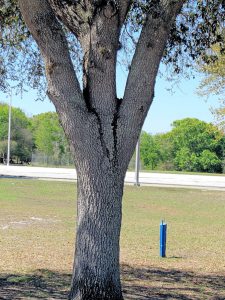
As you are driving around Charlotte County, you are probably astonished by the amount of tree damage. A postmortem on some of this damage may show a defect called a codominant stem. This is a place where two or more stems (branches/leaders) have come together. Now it may look like they are connected, but they are not and could eventually pull apart in a storm like a giant wishbone. This can be a big problem when there is a target nearby such as a car or house. Codominant stems can lead to future tree failures.
How do codominant stems get started and what do they look like? Often, certain trees produce abundant branches which rapidly grow and begin to crowd each other. Codominant stems form when two nearly equal branches grow side-by-side and begin to push up against each other. Look for a “V” – shaped union in the area where they come together – generally less than a forty-five percent angle. Here you will also see what is called “included bark”. This area of included bark shows a definite line or seam where the two stems come together and begin to push against each other – cracks may even develop. If this is noticed when very young, it can be carefully pruned out. Further down the road, it could even be corrected with what is called “subordination” where one stem is selected to remain and the other is pruned down in steps to remove the branch over a period of years. This action slows down the offending stem and speeds up the growth of the remaining stem. Eventually the good stem is dominate and the extra one is totally removed and out of the way. This helps develop a full, well-structured tree.
In general, a tree should have one central leader and four to five scaffold branches aligned around the tree in a whorled pattern. If you were able to look down on the tree from above, it would look like the branches were spaced out like the spokes on a wheel. Structurally sound branches should have “U”- shaped branch/trunk unions with a greater than forty-five-degree angle. Over the years your goal is develop a dominant leader through proper pruning and structural development of sound, well-placed branches and no codominant stems.
If you have missed your chance to deal with codominant stems while they are small or relatively small, you may need the services of a Florida Certified Arborist at this point – please see here – http://www.floridaisa.org/. Florida Certified Arborists can complete work such as bolting or bracing codominant stems. This will structurally enhance the individual tree and keep it from tearing apart in a windstorm. Remember that anyone you hire should have the proper insurance and references.
Trees benefit from proper pruning and training as they grow. The resulting structurally sound trees are safer trees! For more information on trees and pruning, please contact Ralph E. Mitchell, Director/Horticulture Agent for UF/IFAS Extension – Charlotte County. He can be reached at 941-764-4344 or ralph.mitchell@charlottecountyfl.gov. Connect with us on social media. Like us on Facebook @CharlotteCountyExtension and follow us on Instagram @ifascharco.
Resources:
Gilman E. F. & Bisson, A. (2017) Chapter 12—Developing a Preventative Pruning Program: Young Trees. The University of Florida Extension Service, IFAS.
Gilman E. F. & Bisson, A. (2017) Chapter 13—Developing a Preventative Pruning Program: Mature Trees. The University of Florida Extension Service, IFAS.
Source: UF/IFAS Pest Alert



